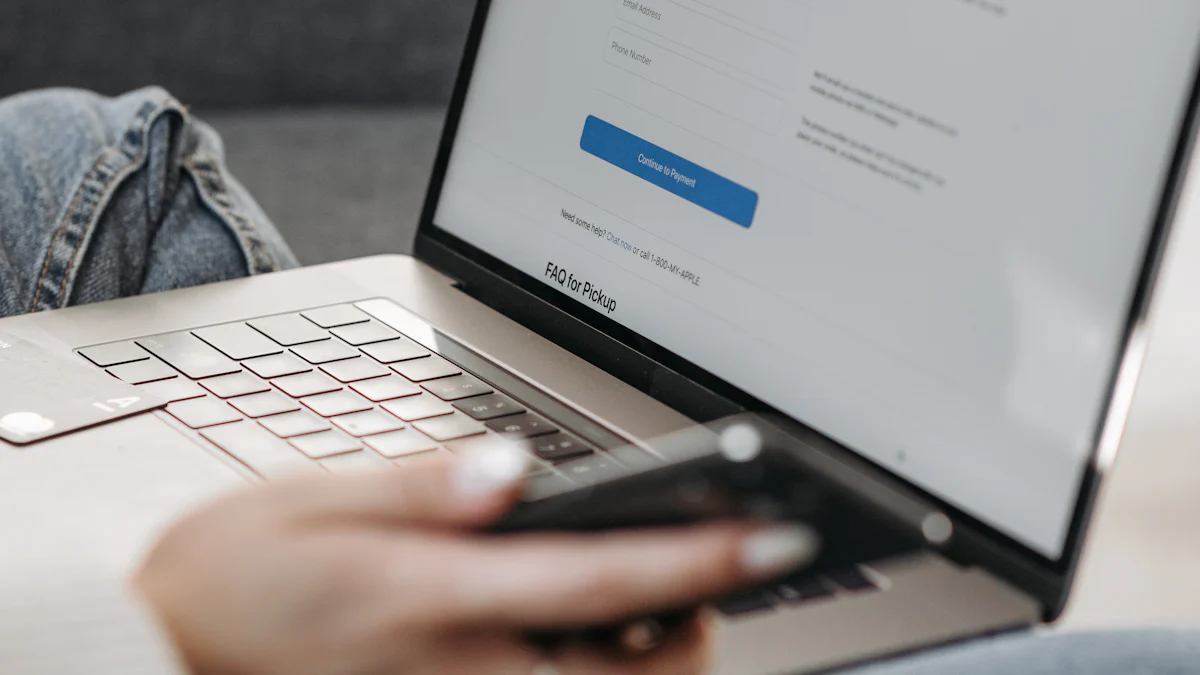How to Write a Follow-Up Email After Accepting a Job Offer
Try Aihirely for
Smarter Interview Prep
Experience real-time AI support tailored to your Resume.
Boost your confidence and ace every question with
AI Mock Interview.

Image Source: unsplash
Knowing who to email after you accept a job offer is an important step in starting your new role on the right foot. Sending a follow-up email allows you to confirm key details, such as your start date or the onboarding process, while also showcasing your professionalism. Reaching out to the right person can help build rapport with your future employer and demonstrate your genuine enthusiasm for the position. Clear communication is essential—research shows it can improve productivity by up to 25% and boost employee confidence by 60%. Taking the time to identify who to email after you accept a job offer and crafting a thoughtful message sets a positive tone for your new journey.
Key Takeaways
-
Find the correct person to email after saying yes to a job. This keeps communication clear and gives you correct details.
-
Show thanks and excitement in your email. Saying thank you creates a good vibe and shows you are happy about the job.
-
Check important details like when you start and training steps. This stops mix-ups and helps you get ready for your new job.
Who to Email After You Accept a Job Offer
Identifying the correct recipient
When you’re ready to send your follow-up email, the first step is figuring out who to contact. Usually, the best person to email is the one who extended the job offer. This could be the hiring manager or someone from the HR team. If you’re unsure, check your offer letter or any previous email threads. These often include the name and contact information of the person you should reach out to.
Sometimes, companies have a dedicated HR representative who handles onboarding. In that case, they might be your go-to contact. If you’ve been communicating with multiple people during the hiring process, don’t hesitate to ask for clarification. A quick question like, “Who should I follow up with regarding my start date and onboarding details?” can save you time and ensure your email reaches the right person.
Why choosing the right person is important for clear communication
Picking the correct recipient for your email is more than just a formality. It ensures your message gets to someone who can provide accurate answers and updates. For example, the hiring manager might confirm your start date, while HR can guide you through paperwork or benefits enrollment. Sending your email to the wrong person could delay responses or create confusion.
Clear communication sets the tone for your professional relationship. By emailing the right person, you show that you’re organized and proactive. This small step can leave a positive impression and help you start your new role on the right foot. Knowing who to email after you accept a job offer is key to keeping things smooth and stress-free.
Step-by-Step Guide to Writing the Email

Image Source: unsplash
Start with a polite and professional greeting
Begin your email with a warm and respectful greeting. Address the recipient by name to make the message feel personal and professional. For example:
-
Use “Dear [Name]” if the tone is formal.
-
Use “Hi [Name]” for a more casual connection.
Personalizing your greeting helps establish a positive rapport right from the start. It shows that you’ve taken the time to address them directly, which can leave a great first impression.
Express gratitude for the job offer and opportunity
Take a moment to thank the recipient for offering you the position. Expressing gratitude sets a positive tone and reinforces your professionalism. A simple line like, “Thank you for this incredible opportunity to join your team,” can go a long way. It also shows your enthusiasm for the role and your eagerness to contribute.
Confirm key details (e.g., start date, location, onboarding process)
Use this part of the email to confirm important details about your new role. This ensures everyone is on the same page and avoids any confusion. Here’s a quick checklist of what to confirm:
-
Your start date.
-
Where you should report on your first day.
-
Who you’ll report to.
-
Any items you need to bring.
-
Insights about the company culture or team.
This step demonstrates your proactive approach and helps you prepare for a smooth transition into your new position.
Ask relevant questions (if needed)
If you have any lingering questions, now’s the time to ask. Keep your questions concise and relevant. For instance, you might ask:
-
“Where should I report on my first day?”
-
“What should I know about the team I’ll be working with?”
-
“Is there anything else I should prepare before starting?”
Asking thoughtful questions shows your interest in the role and your commitment to starting off on the right foot.
Close with enthusiasm and professionalism
Wrap up your email by reiterating your excitement for the role. Use a polite and professional tone to leave a lasting impression. For example, you could say, “I’m thrilled to begin this journey and contribute to the team’s success.” End with a courteous sign-off like “Best regards” or “Sincerely,” followed by your name. This closing reinforces your enthusiasm and sets a positive tone for future interactions.
Practical Tips for Writing an Effective Follow-Up Email
Personalize the email to reflect your excitement for the role
Your follow-up email should feel genuine and tailored to the opportunity. Personalization shows your enthusiasm and helps you stand out. Here are a few ways to make your email unique:
-
Ask about reporting details, like where to go on your first day or what to bring.
-
Inquire about the company culture or team dynamics to show interest in fitting in.
For example, you could say, “I’m thrilled to join the team on [start date] and contribute to [specific project or goal]. Could you share any tips about the team’s work style or culture?” This approach highlights your excitement and curiosity about your new role.
Maintain a professional yet friendly tone
Striking the right balance between professional and friendly is key. Your email should be warm and approachable while staying respectful. Use a clear subject line that reflects the purpose of your email, like “Follow-Up: Excited to Join [Company Name].” Start with a polite greeting, such as “Dear [Name]” or “Hi [Name],” depending on your relationship with the recipient.
Keep your message organized and concise. Use short paragraphs or bullet points to make it easy to read. End with a positive sign-off, like “Best regards” or “Looking forward to hearing from you.” Avoid overly casual language, but don’t be afraid to let your personality shine through.
Proofread for grammar, spelling, and clarity
Mistakes in your email can leave a bad impression, so proofreading is a must. Watch out for common errors like misusing commas, run-on sentences, or confusing homophones. For instance:
-
Incorrect: “Your the best manager I’ve worked with.”
-
Correct: “You’re the best manager I’ve worked with.”
Read your email aloud to catch awkward phrasing or unclear sentences. Tools like spell checkers can help, but a careful review ensures your message is polished and professional.
Keep the email concise and to the point
A concise email respects the recipient’s time and increases the chances of a quick response. Focus on delivering essential information, like confirming details or asking specific questions. Avoid unnecessary details or lengthy explanations. For example, instead of writing, “I was wondering if you could let me know where I should report on my first day and if there’s anything I need to bring,” you could say, “Could you confirm where I should report and what to bring on my first day?”
This direct approach makes your email easier to read and ensures your message is clear. A well-structured, concise email shows you value efficiency and professionalism.
Sample Email Templates for Different Scenarios

Image Source: pexels
Template 1: Confirming start date and onboarding details
When confirming your start date and onboarding details, your email should be clear and professional. Here’s a template you can use:
Subject: Excited to Confirm My Start Date and Onboarding Details
Dear [Recipient’s Name],
Thank you again for offering me the [Job Title] position at [Company Name]. I’m thrilled to join the team and contribute to [specific project or goal, if applicable].
I’d like to confirm my start date as [start date] and ask for any additional details about the onboarding process. Could you let me know where I should report on my first day and if there’s anything I need to bring?
If there are any resources, documents, or next steps I should review before my start date, please feel free to share them. I’m eager to hit the ground running and ensure a smooth transition into the role.
Looking forward to your response!
Best regards,
[Your Full Name]
This template keeps the tone warm and welcoming while ensuring all key details are covered. Personalizing it with specifics about the company or role can make it even more effective.
Template 2: Requesting additional information (e.g., benefits, paperwork)
Sometimes, you might need more details about benefits or paperwork. Here’s how you can ask:
Subject: Follow-Up on Benefits and Paperwork for My New Role
Hi [Recipient’s Name],
I hope this email finds you well! I’m excited to join [Company Name] as [Job Title] and wanted to follow up on a few details. Could you provide more information about the benefits package or any paperwork I need to complete before my start date?
Additionally, if there are forms or documents I should prepare ahead of time, please let me know. I want to ensure everything is in order before my first day.
Thank you for your help, and please don’t hesitate to reach out if you need anything from me.
Best regards,
[Your Full Name]
This email is concise and polite, making it easy for the recipient to respond quickly.
Template 3: Expressing gratitude and excitement without additional questions
If you don’t have any questions but want to express your enthusiasm, try this:
Subject: Excited to Join [Company Name]!
Dear [Recipient’s Name],
I just wanted to take a moment to thank you again for this amazing opportunity. I’m truly excited to join [Company Name] as [Job Title] and contribute to the team’s success.
I’m looking forward to starting on [start date] and meeting everyone. Please let me know if there’s anything I can do to prepare before my first day.
Thank you once again for your support throughout this process. I’m eager to get started and make a positive impact!
Sincerely,
[Your Full Name]
This template is perfect for leaving a positive impression while keeping things simple and professional.
Writing a follow-up email after accepting a job offer doesn’t have to be complicated. Just focus on these key steps:
-
Thank the recipient for the opportunity.
-
Share your excitement about the role.
-
Confirm important details like your start date.
-
Ask any necessary questions.
-
Offer to provide additional information if needed.
Using the provided templates can save you time and ensure your email is polished and professional. They help you stay concise, maintain a friendly tone, and address all the essentials. With these tips, you’ll leave a great impression and start your new role on the right note!
FAQ
What should I do if I don’t get a response to my follow-up email?
Wait 2-3 business days, then send a polite reminder. Keep it short and professional, reiterating your excitement for the role.
Tip: Avoid sending multiple follow-ups too quickly. Patience shows professionalism.
Can I ask about salary or benefits in my follow-up email?
Yes, but only if it wasn’t discussed earlier. Phrase it politely, like:
“Could you confirm details about the benefits package or salary structure?”
Is it okay to follow up via phone instead of email?
Email is preferred for documentation and clarity. However, if you’ve been communicating by phone, a quick call can work. Always remain polite and professional.
Note: If unsure, stick to email—it’s less intrusive.
